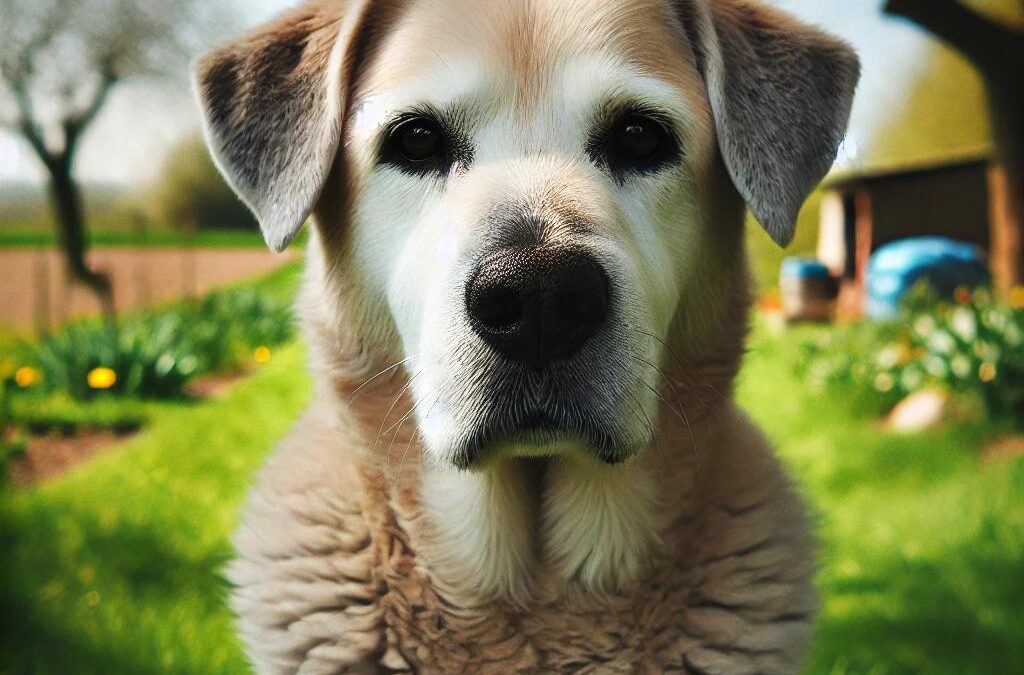
에 의해 TCMVET | 2024년 8월 13일 | 반려동물 한약
Oral fibrosarcoma is a challenging and aggressive cancer that affects dogs, particularly as they age. This tumor type is the third most common oral cancer in dogs, accounting for 10% to 20% of cases. Given its invasive nature and the complications associated with traditional treatments, many pet owners are turning to holistic approaches, including herbal medicine, to manage the condition and improve their dogs’ quality of life.
Understanding Fibrosarcoma in Canine Oral Cavities
Fibrosarcoma typically develops in the connective tissues of the mouth, often affecting the gums and bones of the jaw. This type of cancer is more common in older dogs, particularly males, with the average age of onset around 8 years. The tumor is known for its aggressive behavior, frequently invading surrounding bone and making surgical removal difficult.
Early symptoms of oral fibrosarcoma in dogs can include swelling in the mouth, difficulty eating, drooling, bad breath, and sometimes bleeding. As the tumor progresses, it may cause visible changes to the dog’s jaw structure, leading to pain and significant discomfort.
The Impact of Bone Invasion
One of the major challenges in treating fibrosarcoma is its tendency to invade the bone. At diagnosis, imaging studies reveal that bone invasion is present in 60% to 65% of cases. This complicates treatment, as the tumor becomes more difficult to remove completely. Even with aggressive surgical and radiation therapy, the risk of recurrence remains high.
Given these challenges, many pet owners are exploring complementary therapies to support their dogs’ health and manage the symptoms associated with fibrosarcoma.
The Role of Herbal Medicine in Managing Fibrosarcoma
Herbal medicine offers a holistic approach to managing fibrosarcoma, focusing on improving the dog’s overall health, boosting the immune system, and supporting conventional treatments. Traditional Chinese Medicine (TCM) has long been used to treat various cancers, including fibrosarcoma, with a focus on balancing the body’s energy and promoting natural healing processes.
허브 등 Huang Qi (Astragalus), Ban Zhi Lian (Scutellaria barbata), and 바이 후아 쉬쉬 카오 (Hedyotis diffusa) are commonly used in TCM to support cancer treatment. These herbs are believed to have anti-inflammatory, immune-boosting, and anti-cancer properties, helping to slow tumor growth and alleviate symptoms.
In addition to TCM, Western herbal medicine also offers options such as turmeric, known for its powerful anti-inflammatory and antioxidant properties. Curcumin, the active ingredient in turmeric, has been studied for its potential to inhibit cancer cell growth and enhance the effectiveness of conventional cancer treatments.
한약과 기존 치료법의 통합
While herbal medicine can offer significant benefits, it is essential to integrate these treatments with conventional veterinary care. Surgery and radiation therapy remain the primary treatments for fibrosarcoma, especially when the tumor involves bone. However, herbal supplements can be used alongside these treatments to enhance the dog’s overall health, manage side effects, and potentially reduce the likelihood of recurrence.
Pet owners should work closely with a veterinarian knowledgeable in both conventional and herbal medicine to develop a comprehensive treatment plan tailored to their dog’s specific needs.
Oral fibrosarcoma in dogs is a serious and aggressive cancer that poses significant treatment challenges, particularly when bone invasion is involved. While conventional treatments like surgery and radiation therapy are essential, integrating herbal medicine can provide additional support to manage symptoms and improve the dog’s quality of life. By taking a holistic approach, pet owners can help their dogs navigate the complexities of fibrosarcoma with greater comfort and care.

에 의해 TCMVET | 2024년 8월 13일 | 개 암 및 종양
Oral fibrosarcoma is a malignant tumor that arises in the connective tissues of the mouth and poses significant challenges due to its aggressive nature and tendency to invade surrounding bone. This type of cancer is the third most common oral tumor in dogs, affecting 10% to 20% of all canine oral cancer cases. Understanding the implications of bone invasion by fibrosarcoma is crucial for effective diagnosis, treatment, and management.
The Aggressive Nature of Fibrosarcoma
Fibrosarcoma in dogs is known for its aggressive behavior, particularly its ability to infiltrate surrounding bone structures. This characteristic makes it one of the more challenging oral cancers to treat. The tumor typically develops in the gums, often in the upper jaw, between the canine teeth and premolars. Once it invades the bone, the tumor becomes much harder to remove surgically, leading to a higher likelihood of recurrence.
At the time of diagnosis, imaging studies reveal bone invasion in approximately 60% to 65% of cases. This level of infiltration complicates the treatment process and often requires a more aggressive approach to manage the disease effectively.
Symptoms and Clinical Signs
Dogs with oral fibrosarcoma may exhibit a variety of symptoms, many of which are related to the tumor’s impact on the surrounding tissues and bone. Common signs include swelling in the mouth, difficulty eating, drooling, and bad breath. In more advanced cases, the tumor may cause visible distortion of the jaw, oral bleeding, and significant discomfort.
The presence of bone invasion can exacerbate these symptoms, leading to pain and functional impairments in the affected area. Early detection is critical to prevent the tumor from reaching this advanced stage.
Diagnosis and the Role of Imaging
Diagnosing oral fibrosarcoma involves a combination of physical examination, imaging techniques, and biopsy. Imaging is particularly important in cases of suspected bone invasion, as it provides a clear view of the extent of the tumor’s spread. X-rays, CT scans, or MRI may be used to assess how deeply the tumor has infiltrated the bone, guiding treatment decisions.
Biopsy is necessary to confirm the diagnosis and determine the tumor’s exact nature. Once confirmed, the treatment plan is tailored to the individual dog’s condition, taking into account the extent of bone involvement.
Treatment Options and Challenges
Treating fibrosarcoma with bone invasion is challenging due to the tumor’s aggressive nature. Surgical removal is the primary treatment option, but complete excision is often difficult when the tumor has deeply infiltrated the bone. In such cases, partial jaw removal may be necessary to achieve clear margins and reduce the risk of recurrence.
Radiation therapy is often recommended as an adjunct treatment to manage any remaining cancerous cells and to control the tumor locally. However, even with aggressive treatment, the risk of recurrence remains high, making long-term monitoring essential.
For cases where surgery is not feasible or the tumor recurs, palliative care options are available to manage pain and maintain the dog’s quality of life.
Prognosis and Long-Term Care
The prognosis for dogs with oral fibrosarcoma involving bone invasion is guarded, particularly if the tumor is not detected early. Early intervention and a comprehensive treatment plan can improve outcomes, but ongoing care and monitoring are critical to manage the disease effectively.
Regular follow-up visits are necessary to detect any signs of recurrence, and additional treatments may be required if the tumor returns.
Oral fibrosarcoma with bone invasion presents significant challenges in canine health care. Understanding the aggressive nature of this tumor and the importance of early detection can help improve the quality of life for affected dogs. A proactive approach involving regular veterinary check-ups and prompt treatment is essential in managing this complex condition.

에 의해 TCMVET | 2024년 8월 13일 | 개 암 및 종양
Fibrosarcoma is a type of cancer that develops in the fibrous connective tissues and is a significant concern in canine oral health. This particular tumor is the third most common oral tumor found in dogs, representing 10% to 20% of all oral cancers. Understanding its prevalence and impact on dogs is crucial for pet owners and veterinarians who aim to manage this condition effectively.
Prevalence of Oral Fibrosarcoma in Dogs
Oral fibrosarcoma predominantly affects older dogs, with the average age of diagnosis being around 8 years. Male dogs are more frequently diagnosed with this type of cancer, indicating a potential gender predisposition. While the exact cause of fibrosarcoma is not fully understood, genetic factors, environmental influences, and chronic inflammation may play a role in its development.
This type of tumor most commonly appears in the gums, particularly in the upper jaw between the canine teeth and premolars. It is known for its aggressive nature, often infiltrating the surrounding bone and tissues, which complicates treatment efforts.
Clinical Impact and Challenges
Fibrosarcoma in the oral cavity presents a range of clinical challenges due to its invasive nature. The tumor typically appears as a firm, flat mass that is deeply attached to the underlying tissues, making surgical removal difficult. At the time of diagnosis, imaging studies often reveal that the tumor has already invaded the bone in 60% to 65% of cases. This makes early detection and intervention critical to managing the disease effectively.
One of the significant impacts of oral fibrosarcoma is its potential to cause discomfort and functional issues in affected dogs. Symptoms may include difficulty eating, drooling, oral bleeding, and bad breath. These symptoms can severely affect a dog’s quality of life, making early diagnosis and treatment essential.
진단 및 치료
The diagnosis of oral fibrosarcoma typically involves a combination of physical examination, imaging techniques like X-rays or CT scans, and biopsy to confirm the presence of cancerous cells. Given the tumor’s aggressive nature, treatment usually involves surgical removal of the tumor, often followed by radiation therapy to reduce the risk of recurrence.
However, complete surgical excision can be challenging due to the tumor’s tendency to infiltrate surrounding bone and tissue. In some cases, even after surgery, the tumor may recur, requiring additional treatments. For dogs with advanced or recurrent fibrosarcoma, palliative care may be necessary to manage symptoms and maintain quality of life.
Prognosis and Long-Term Outlook
The prognosis for dogs with oral fibrosarcoma varies depending on the size, location, and extent of the tumor at the time of diagnosis. Early detection and aggressive treatment can improve the chances of a favorable outcome, but the risk of recurrence remains high due to the tumor’s invasive nature. Regular follow-up care is essential to monitor for any signs of recurrence and to manage the dog’s overall health.
Oral fibrosarcoma is a challenging condition that significantly impacts the health and well-being of affected dogs. Understanding its prevalence, symptoms, and treatment options is crucial for pet owners and veterinarians alike. With early detection and appropriate care, the quality of life for dogs with fibrosarcoma can be significantly improved.

에 의해 TCMVET | 2024년 8월 13일 | 개 암 및 종양
Fibrosarcoma is a significant concern in veterinary oncology, particularly when it comes to canine oral health. This type of tumor is the third most common oral tumor in dogs, accounting for approximately 10% to 20% of all cases. The condition predominantly affects older dogs, with the average age of onset being around 8 years. Interestingly, fibrosarcoma is more frequently diagnosed in male dogs, making it a crucial topic for pet owners and veterinarians alike.
Understanding Fibrosarcoma in Dogs
Fibrosarcoma is typically found in the gums, particularly between the canine teeth and premolars. The tumor often manifests as a flat, firm mass that is closely connected to deeper tissues. These growths are notorious for their invasive nature, particularly in the upper jaw where they often affect the hard palate and cheek mucosa.
One of the major challenges with fibrosarcoma is its tendency to invade surrounding bones. This makes surgical removal difficult and increases the risk of local recurrence. In fact, imaging studies show that bone invasion occurs in 60% to 65% of cases at the time of diagnosis. However, it’s important to note that metastasis to the lungs occurs in less than 10% of cases, and regional lymph node involvement is relatively uncommon.
증상 및 진단
Pet owners should be aware of the symptoms of fibrosarcoma, which may include swelling in the mouth, difficulty eating, drooling, and bad breath. In some cases, the tumor may bleed, leading to additional discomfort for the dog. Early detection is critical for effective management, so regular veterinary check-ups are essential, especially for older male dogs.
Veterinarians typically use a combination of physical examination, imaging techniques, and biopsy to diagnose fibrosarcoma. Once confirmed, treatment options often involve surgical removal of the tumor. Due to the tumor’s aggressive nature, complete excision is difficult, and recurrence is common. Therefore, additional treatments such as radiation therapy may be recommended to control the disease.
Prognosis and Management
The prognosis for dogs with fibrosarcoma varies depending on the size and location of the tumor, as well as the extent of bone involvement. While surgery is the primary treatment, the likelihood of recurrence means that ongoing monitoring and follow-up care are essential. In cases where the tumor cannot be entirely removed, or if it recurs, palliative care options are available to ensure the dog’s comfort.
Fibrosarcoma is a serious but manageable condition in dogs, particularly older males. By understanding the risks, symptoms, and treatment options, pet owners can ensure that their dogs receive the best possible care. Early detection and a comprehensive treatment plan are key to improving the quality of life for dogs affected by this challenging condition.

에 의해 TCMVET | 2024년 8월 11일 | 개 암 및 종양
Squamous cell carcinoma (SCC) is a well-known and aggressive form of cancer in dogs, primarily affecting older animals. However, a specific variant known as papillary squamous cell carcinoma can also occur in younger dogs. This variant, while generally less aggressive than its conventional counterpart, still poses significant risks and requires careful attention. Understanding papillary SCC in young dogs is crucial for early detection, effective treatment, and improving the long-term prognosis of affected pets.
What Is Papillary Squamous Cell Carcinoma?
Papillary squamous cell carcinoma is a subtype of SCC that is characterized by its unique appearance and growth pattern. Unlike the more common forms of SCC, which often present as irregular, invasive masses, papillary SCC typically manifests as exophytic (outward-growing) lesions with a wart-like or cauliflower appearance. These tumors are usually well-differentiated, meaning that they retain some characteristics of normal cells, which can make them less aggressive in their behavior.
Key Characteristics of Papillary SCC in Young Dogs:
- Occurrence in Younger Dogs: While most squamous cell carcinomas are seen in older dogs, papillary SCC can appear in younger animals, sometimes as early as 2-3 years of age. This makes it an important variant to recognize, particularly in breeds that may be predisposed to cancer.
- Localized Growth: Papillary SCC tends to grow locally and is less likely to invade surrounding tissues compared to other forms of SCC. This localized growth means that, when detected early, the cancer can often be removed with a good prognosis.
- Lower Metastatic Potential: One of the most significant differences between papillary SCC and more aggressive variants is its lower potential for metastasis. While papillary SCC can be invasive, it is less likely to spread to lymph nodes or distant organs, making it somewhat easier to manage with localized treatment.
Risk Factors and Diagnosis
Certain breeds of dogs may be more predisposed to developing papillary squamous cell carcinoma. Breeds such as Boxers, Beagles, and Golden Retrievers have been noted to have a higher incidence of this cancer variant, though it can occur in any breed.
Key Diagnostic Tools:
- 신체 검사: Regular veterinary check-ups are essential, especially for younger dogs showing signs of oral discomfort or visible growths. Early detection is crucial for a favorable outcome.
- 생검: If a suspicious lesion is found, a biopsy is typically performed to confirm the diagnosis of papillary SCC. The histopathological examination will reveal the characteristic papillary structure of the tumor.
- 이미징: In some cases, imaging studies such as X-rays or CT scans may be used to assess the extent of the tumor and to check for any signs of local invasion or distant spread.
Treatment Options for Papillary SCC
Given the localized nature of papillary SCC, treatment is often more straightforward than with more aggressive forms of SCC. The primary treatment options include:
- 외과적 제거: Surgery is the most common treatment for papillary SCC, especially if the tumor is detected early. The goal is to remove the tumor completely, with clear margins to reduce the risk of recurrence.
- 방사선 치료: In cases where the tumor cannot be completely removed or if it recurs, radiation therapy may be used to target any remaining cancer cells. Radiation is effective in controlling localized disease and can improve the chances of long-term remission.
- 정기 모니터링: After treatment, regular follow-up visits are essential to monitor for any signs of recurrence. While papillary SCC is less likely to metastasize, it can recur locally, so ongoing vigilance is necessary.
Prognosis and Long-Term Outlook
The prognosis for young dogs with papillary squamous cell carcinoma is generally favorable, particularly when the cancer is detected early and treated promptly. The lower metastatic potential and localized growth pattern of papillary SCC mean that many dogs can achieve long-term remission or even be cured with appropriate treatment.
However, as with any cancer, early detection is key. Pet owners should be vigilant for any signs of oral tumors or discomfort in their dogs and seek veterinary care if any abnormalities are noticed.
Papillary squamous cell carcinoma in young dogs, while less aggressive than other forms of SCC, still requires careful attention and early intervention. Understanding the unique characteristics of this variant can help veterinarians and pet owners make informed decisions about diagnosis, treatment, and long-term care. With proper management, many dogs with papillary SCC can enjoy a good quality of life and a positive prognosis.






